

































by John T. Molloy
First Edition, October 1976
Summary Copyright © 2005 by
Robert Wayne Atkins, P.E.
All Rights Reserved.
The following summary is for fair use and educational purposes only.
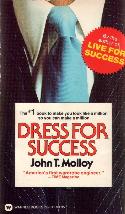 FACT: Most American men dress for failure. They do so because they make one or more of the four suicidal mistakes:
FACT: Most American men dress for failure. They do so because they make one or more of the four suicidal mistakes:There is a way to avoid making any of those mistakes and to dress for success instead. Let research choose your clothing. My research is unique in concept, scope, and results. It has been conducted over a period of fifteen years and includes the opinions and subconscious reactions of over 15,000 executives in all phases of business, as well as those of a wide cross section of the general public. (11)
The way we dress has remarkable impact on the people we meet professionally or socially and greatly (sometimes crucially) affects how they treat us. (11)
FACT: People who look successful and well educated receive preferential treatment in almost all of their social and business encounters. (12)
Naturally, successful dress cannot put a boob in the board room, but incorrect dress can definitely keep an intelligent, able man out. (18)
The suit is the single most important garment that every man wears - and not only because it is the most expensive and requires the greatest amount of time for selection and fitting. It is the garment on which most people judge the wearer's status, character, and ability. And because it covers the upper torso, which is the focal point of most people with whom we communicate, it is the central power garment - the garment that establishes our position as inferior, equal, or superior in any in-person business situation. (37)
Pants are always fitted from the top down, and the first area of fit you must check is the waist. The proper position for a man's pants waist is slightly above the navel, and exactly horizontal to the ground, all the way around. If the waist is too high or too low and cannot be corrected, take off the pants and do not buy the suit. (41)
Assuming that the height of the waist is correct, then it should be neither too loose nor too tight. It is too loose if it slips at all when you move. It is too tight if you cannot comfortably slip the flat of your hand in and out. (41)
The seat area should be smooth and comfortable when sitting and standing. If the crotch is too big, have that area pinned also. (41)
The final aspect of pants fit is the length. The decision of whether to finish the bottoms with turned up cuffs or plain bottoms is yours. If you prefer plain bottoms, they should break in front and be one-half to three-quarters of an inch longer in the back. If you wear cuffs, it is usually best if they are tailored so they hang exactly horizontal to the ground and there are no wrinkles or bulges when the cuff is made. (41-42)
If the suit has a vest, it must also be fitted and pinned. A vest should fit smoothly, with no pulling or sagging when sitting or standing. The armholes should be open enough for comfort but not sag. The back should have no wrinkles and not ride up during normal activity. (42)
When you put on the suit jacket, the first and most important aspect is how it feels. I don't care how it looks, if it does not feel perfectly comfortable sitting, standing and moving around, then don't buy it. (42)
As with the pants, the fit of the jacket begins at the top, at the neck. Look at the neck area carefully; if it does not fit absolutely flat, with no wrinkles or bulges, tell the fitter to fix it. The jacket must next fit around the chest and waist. If you have a thin waist, your jacket should be a bit more tightly fitted than if you are heavy. The reason is that when you sit, the jacket will tend to bulge if you have a bit of a stomach; but it won't if you don't. (43)
Sit down with the jacket buttoned and see how it looks. If it pulls noticeably, have it adjusted. (44)
Now curl your fingers under the bottom of the jacket. If the bottom just fits into the curl, it is correct. (44)
The tip of the jacket sleeves should come approximately five inches off the top of the thumb, never more than five and one-half. (44)
Now for the second fitting: When you return, allow yourself enough time - take enough time - to see that it fits absolutely correctly. The difference between a good fit and a bad fit is very often the second fitting, and too many simply ignore this point. Don't. Insist on it even if causes long faces and the suit is carefully wrapped up and ready to go. When you go back, the procedure is exactly the same as before. You're paying for a suit that fits - so get it. (44-46)
The best material a suit can be made of is wool. Wool takes dyes better than any other fabric. It doesn't snag; it fits well; it doesn't lose its shape; it is resilient; it lays better on the body; in winter it is warmer; and it outlasts any other fabric. The second best suit fabric is the polyester and wool blend. The fact is that nine out of every ten good business suits are made from wool or wool blends, and most men would do just as well if they never wore anything else. (48-49)
The proper colors for a gentleman's suit are blue, gray, and beige, and shades thereof. Browns and blacks are sometimes acceptable, but because of the many times when they are not, I would suggest that most men avoid them. (49)
Suit patterns are relatively simple. Solid suits, the staple of every man's wardrobe, should look rich and soft if they are standard business suits. (49)
Two types of stripe are acceptable in men's business suiting. The first is the pinstripe, and it is a very narrow vertical stripe. The greatest majority of these have white or blue stripes, and although other colors are acceptable, white is by far the most sophisticated. Chalk stripes are wider than pinstripes, generally about one-eight of an inch, and they are very tricky. A chalk stripe can label you as a Wall Street executive or a Chicago gangster. If a chalk stripe looks gaudy, don't buy it. (49-50)
Several types of plaid are acceptable. The first is the almost invisible plaid. There's a plaid there, but you must look carefully to see it. The suit is usually of a dark color, with the pattern woven in threads of slightly lighter or slightly darker shades of the same color. This suit is always acceptable. (50-51)
Because the suit is the central power garment in any business combination, it is the garment that will most influence any viewer's stereotyped judgment of the wearer. (51-52)
The darker the suit, the more authority it transmits. The most authoritative pattern is the pinstripe, followed in descending order by the solid, the chalk stripe and the plaid. If you need to be more authoritative, stick with the dark pinstripe. (52)
Suits that will give you the most credibility with people of the upper-middle class are dark blue and dark gray solids, and pinstripes in both colors. (52)
The following table is a summary of the information on pages 52 to 54. The following data was based on 15 years of research involving over 15,000 businessmen in all phases of business. It is NOT just the simple opinion of the author.
| Suit Color/Pattern | Upper-Middle Class | Lower-Middle Class | Tall Men | Short Men | Heavy Men | Thin Men | Weak Authority | Strong Authority |
| Solid Navy | Positive | Positive | Negative | Negative | Positive | Neutral | Positive | Negative |
| Solid Dark Gray | Positive | Negative | Positive | Negative | Positive | Neutral | Positive | Neutral |
| Dark Blue Pinstripe | Positive | Negative | Negative | Positive | Positive | Negative | Positive | Negative |
| Dark Gray Pinstripe | Positive | Negative | Neutral | Neutral | Positive | Negative | Positive | Negative |
| Medium Blue Solid | Positive | Positive | Positive | Positive | Neutral | Neutral | Positive | Positive |
| Medium Gray Solid | Positive | Negative | Positive | Neutral | Negative | Positive | Neutral | Positive |
| Medium Gray Pinstripe | Positive | Negative | Negative | Positive | Neutral | Neutral | Positive | Negative |
| Medium Blue Pinstripe | Positive | Negative | ? | Negative | Neutral | Negative | Positive | Positive |
| Light Blue Solid | Positive | Positive | Positive | Negative | Negative | Positive | Negative | Positive |
| Light Gray Solid | Positive | Positive | Positive | Negative | Negative | Positive | Negative | Positive |
| Dark Brown | Negative | Neutral | Negative | Negative | Neutral | Negative | Negative | Negative |
The most common material . . . is cotton. Unfortunately, cotton wrinkles like hell when you're wearing it.(57-58)
The next most popular material for shirts are the polyester and cotton blends (usually 65 percent polyester and 35 percent cotton, although there are variations). Polyester and cotton shirts are those usually referred to as "wash-and-wear," and while they cannot simply be washed and put on with no ironing at all, they do require only a minimum amount, just a touch-up, to look fine. The polyester and cotton wrinkle hardly at all, and after long hours of wear look better than cotton. For most men . . . they are almost the perfect shirt. (58)
A growing number of dress shirts are knits. The disadvantage are that knits snag badly. They also always look like knits, and should be generally avoided for that reason. (58)
Silk very rarely has an acceptable look for business purposes. If the laundry doesn't ruin it on the first try, they will on the second. (58)
Avoid any shirt that has a shiny look to it, as well as all see-through weaves. (58-59)
The first area where a shirt should fit is around the waist. The shirt should be smooth all the way around, with no bagginess or bunching of material anywhere, but still loose enough to allow comfortable movement and to allow you to sit down without having the material pulling at the buttons. (60-61)
The second area of fit is the length. A shirt should be long enough that it does not pull out of your pants during normal activity. When you buy a shirt, check the length, and when you find a comfortable one, stick with that brand and cut. Make sure the bottom button falls at least three-inches below the waistband of your pants. (61)
The third area of fit is the collar. This is the most crucial place, and also where most men are wearing the wrong size. They had it right a year ago, but they've put on fifteen or so pounds, and now that size is too tight. The problem often is that it may not feel too tight, but it looks it. Usually middle-aged men wear their collars too tightly and men in their fifties, who are beginning to lose weight and get a few wrinkles in their necks, tend to wear them too loosely. (61)
Shirt sleeves are measured from a point midway between the shoulders down to the wrists. The end of a shirt sleeve should come just a fraction below the wrist bone, and should extend about one-half inch below your suit jacket sleeve. (62-63)
In any test, the most acceptable dress shirts - those that elicit the best responses for taste, class, credibility and effectiveness - are still, and will continue to be, white and solid colors. When properly color-coordinated or contrasted, solids go with every suit and every tie made. Of the solids, blue is the most popular, followed by the other pastels, the paler the better. A gaudy, loud yellow is not a good business shirt, but a pale pastel yellow is. (63-64)
Never wear pink or pale lavender shirts, which have negative masculine associations. Never wear a solid red shirt, no matter who you are or what you do; it's just never acceptable. If you have a shallow complexion, you should avoid any shades of gold, green, or gray, which generally do not enhance anyone's facial coloration. (64)
To avoid looking like a gangster, always make sure that your shirt is lighter than your suit, and your tie darker than your shirt. (64)
Several types of shirts are basically solid, but have a texture or pattern because the colored threads are interwoven with white threads. These are the end-on-end weave and the Oxford cloth, and both are not only highly acceptable shirts, they also add a richness, texture and variety to the solid look. (65)
The second acceptable pattern in shirting is the simple stripe. The stripes may range from the very thin pinstripe to as wide as one-sixteenth of an inch. Generally, the closer the stripes are to each other, the more acceptable the shirt. The stripe can be of any color that coordinates or contrasts with the suit, as long as it is on a white background. The stripes should always be a single color, on a single color background. Basically, the multi-colored stripe projects a lower-middle class association in most people. (65-67)
If you intend to take anything I've said in this book at all seriously, note well the following: You will never, ever, as long as you live, wear a short sleeve shirt for any business purpose, no matter whether you're the office boy or the president of the company. Short sleeve shirts are symbols of the lower-middle-class, and therefore pack no psychological authority or power. (70-71)
No dress shirt should have epaulets or decorative pleats or cowboy yokes or be sewn with thread that is different in color from that of the shirt fabric. Buttons should be plain and simple and usually white. (72)
I asked the desk sergeant if the cops ever arrested anyone wearing a tie. "Hardly ever," was his reply. (75)
Because I learned very early in my research that ties are so important, I have probably conducted more experiments with them and more testing of them than I have with any other article of clothing. (75)
In one set of experiments, I asked a group of men to apply for jobs that were available and for which they were reasonably qualified. Invariably, those men who wore their ties to interviews were offered jobs; those without them were turned down. (75-76)
The tie is a symbol of respectability and responsibility; it communicates to other people who you are, or reinforces or detracts from their conception of who you should be. While the most appropriate tie, worn correctly, naturally cannot insure your success in business or life, it certainly can - and should - give off the right signals to keep you from being regarded as a no-class boob. (77)
Accept the fact that buying and wearing ties correctly is a very serious matter, one that requires time, effort and thought. And do it yourself; I guarantee that it will pay off. (83)
The first thing you should do before buying a tie is to determine what length they should be. There is little that looks worse on a man that a tie that is either too long or too short. When tied properly, the tip of the tie should come just to your belt buckle, no more, no less. What length you will need therefore depends on how tall you are and how you knot your tie. (83)
Basically the width of the tie should be harmonious with the width of the suit lapels. Standard tie widths are from four to four and one-half inches at the widest end. (83)
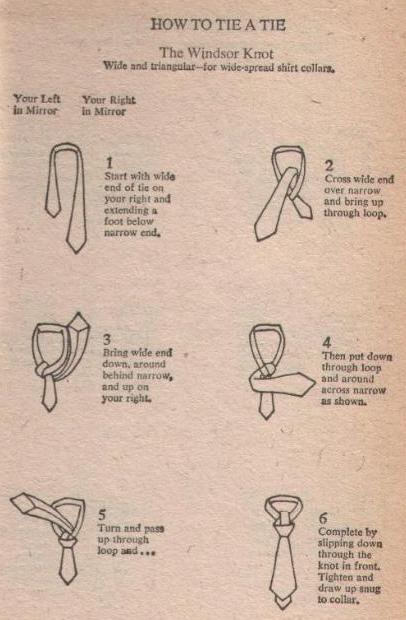
The best material for ties is silk; the next best is polyester that looks like silk. (83)
The most obvious pattern for a tie, the one that is the most useful generally, is no pattern at all. In other words, a solid. The reason is simple. A solid tie will go with any patterns in any suits or shirts. For a basic tie wardrobe, I suggest that every man have at least a solid blue tie, and one other solid from the following: brown, beige, or maroon, depending on the wardrobe. (85)
The next pattern we find in ties is the evenly spaced, repeating pattern. The best known of these is, of course, the polka-dot, a small round dot repeated in regular intervals against a solid background. The most common polka-dot tie is dark blue with a white dot, and the reason is traditional. Generally speaking, the smaller the dots, the more sophisticated and dressy the tie. (86-87)
The next category of acceptable tie patterns . . . is the Ivy League tie. It's a tie that traditionally indicated that the wearer was not only of a certain class, but that he also belonged to an elite social group. There are several variations of the Ivy League tie, but generally it features a small rounded triangle or irregular circle with variations inside. Whatever the designs, they are always crisp, neat, and repeated on fine silk. (88-89
An offshoot is the repeating diamond pattern. As with the polka-dot, the smaller the diamonds are, the more sophisticated is the tie. This is probably the best tie for a man in an authority position, since it says he is conservative and upper class to the members of the upper-middle class without turning off the lower-middle class with which the man might come in contact. The traditional Ivy League tie, because of its prior association, does tend to turn off the lower-middle class. (90)
Never wear ties with large symbols. Never wear "storybook" or "big picture" ties, I don't care what the prevailing fashion is. Avoid any tie that is too short. Avoid black ties unless you are going to a funeral. Avoid purple under all conditions. And avoid any pattern that is just hard to look at. (91)
When putting clothing together, it is very important that a pattern that travels in one direction is not put next to a pattern that travels in another direction; the lines will clash. The simplest, effective and always acceptable combination of clothing is solids. (95)
Examples of good combinations appear in the following pictures taken from pages 120 to 121.
 | 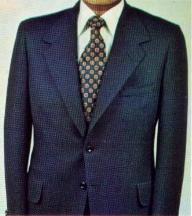 | 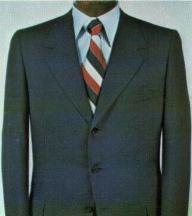 | 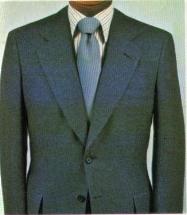 |
| Striped Suit | Solid Suit | Striped Suit | Solid Suit |
| Striped Shirt | White Shirt | Solid Shirt | Striped Shirt |
| Plaid Tie | Ivy League Tie | Stripe Tie | Solid Tie |
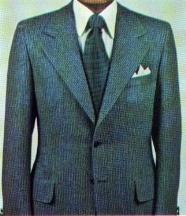 | P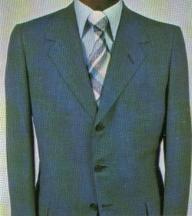 |  |
| Striped Suit | Plaid Suit | Stripped Suit |
| White Shirt | Solid Shirt | Solid Shirt |
| Polka-Dot Tie | Plaid Tie | Solid Tie |
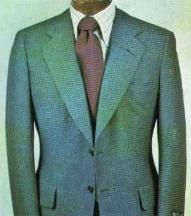 | 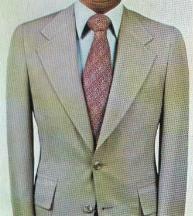 | 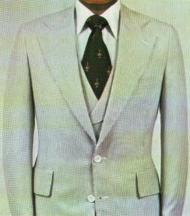 |
| Solid Suit | Beige Suit | Summer Striped Vest Suit |
| Plaid Shirt | Textured Shirt | Solid Shirt |
| Solid Tie | Textured Tie | Club Tie |
I am frequently asked if there are any traits common to all successful executives. There most definitely are: they always have their hair combed and their shoes shined. And they expect the same of other men, particularly subordinates. (121)
Most men should not wear facial hair of any kind. The response to facial hair is always negative in corporate situations, and the only men who should wear it are those men who must compensate for some other weakness in their appearance or personality. A beard and/or a mustache can make a man more powerful and more masculine looking. If a man looks very young, a mustache or beard can speed up the aging process. (122)
If you have a choice, dress affluently.
Always be clean.
Never wear green.
Never put anything on your hair that makes it look shiny or greasy.
Never wear sunglasses, or glasses that change tint as the light changes. People must see your eyes if they're to believe you.
Never wear any jewelry that is not functional, and keep that simple.
If it is part of your regalia, always carry a good attaché case.
Always carry a good pen and pencil, not the cheap, junky ones.
If you have a choice, wear an expensive tie.
Never take off your suit jacket unless you have to. It weakens your authority. (117-118)
Within reason, there are no unacceptable belts; the buckle is the problem. Big, heavy, or ornate buckles tend to be unacceptable; small, clean, traditional buckles with square lines are best. (155)
All wallets are okay, but the longer "pocket secretary" that can only be carried in the suit pocket is definitely an upper-middle class symbol; others are only neutral. (156)
A man's umbrella should be black, preferably of the non-fold up type, with a clean, simple handle.
Men's handkerchiefs should be cotton or linen, hand rolled and white. Handkerchiefs worn in the breast pocket of the suit are not uncommon among older men and are perfectly acceptable with conservative suits. Very young men who wear pocket handkerchiefs tend to look affected. Colored handkerchiefs, or handkerchiefs that match ties, should be worn by no one. (158)
Acceptable colors for business shoes are black, brown, and cordovan. The wingtip and other plain lace shoes are the traditional footwear of the American businessman. (159)
A gentleman's watch is thin, plain, and gold, with either a gold or leather band. Gentlemen do not wear skin-diver watches or astronaut's watches or Mickey Mouse watches to the office. Gentlemen do not wear cheap expandable bands; they are a symbol of the lower classes. (160)
THE END
